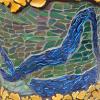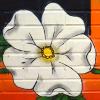Art Notes
The Synthetic Mind

Dena Zilber's drawings are on display at ATHICA through Sept. 9.
“ATHICA Emerges V: The Synthetic Mind,” this summer’s installment of the gallery’s semi-annual exhibition of locally based emerging artists, seeks to explore the different ways in which people perceive and experience their surroundings through filters of neurobiological, sociological, cultural and artificial influences. Co-curators Emily Green Barrera, Kathryn Clark, Natasha Day, Meredith Drury and Bess Gaby, under the guidance of Artistic Director Emerita Lizzie Zucker Saltz, selected seven artists whose works compliment those of featured artists Brian Hitselberger and Ben McKee.
Brian Hitselberger presents four portraits paired with celestial images on hardback book covers in “Arguments for and Against Solitude,” equating the vastness of the galaxy with the privacy of friends. Each meticulously drawn portrait never offers a clear view of the face, emphasizing the act of contemplation. “Self Portrait In and Out of Sleep,” a giant patchwork of splattered prints mimicking cosmic bodies, hosts two comparatively small and nearly identical self-portraits, one sleeping and one waking, further hinting at the subconscious mind’s important role in creative productivity.
He elaborates, “I have a theory that art can only ‘work’ if the ideas that are poured into its initial inception are drawn from a shared well of experience... it must in some way contain an idea that you yourself may have had or felt in some form at some point in your life. [This concept] razes to the ground the possibility that our backgrounds, ages, genders or class separate us from each other in any substantive manner.”
Dena Zilber’s collection of imaginative, slightly peculiar pen-and-ink drawings spans the wall like a collage of memories, daydreams and personal vignettes. Playful, often whimsical images, like carousels, balloons, bicycles, a tree house and a pumpkin patch, are juxtaposed against endearing sketches of herself and friends, often playing music together. Beds, which appear in several of the drawings, reinforce the overall dream-like quality of her work.
“Enter These Shallow Waters” by Justine Stevens is a series of tiny abstract landscapes on paper, all delicately detailed with combinations of ink, pencil, paint, beads, glitter, sequins and holograms. She explains, “Right now, I'm very interested in ocean life, like coral communities and deep-water creatures. The ocean is such a huge part of our planet but is completely alien to us, which makes it a pretty good analog for the unconscious. In my work, I try to let the viewer have a glimpse into these other worlds that are sort of like real places, but mostly like ideas of places, or how they would look in dreams.”

By Justine Stevens
Elizabeth Kleene’s vibrant paintings depict abstractions and fragmentations of images, exploring the complexity of gathering sensory data. “Many people now think about the human brain as being a kind of very complicated computer, and a lot of my work has to do with thinking about consciousness in these terms," she says.
By first processing photographs through computer-editing programs to digitally manipulate their lighting, focus, grain and colors before painting them onto canvas, Bob Davis similarly creates abstracted images that alter visual perception of reality.
Several of the participating artists’ works revolve around manmade technology and how it challenges sensory interpretation and communication. Featured artist Ben McKee’s kinetic sculptures take on eerily lifelike behaviors through their movements, hinting at machinery’s struggle towards artificial intelligence. In “Beneath the Surface,” thin metal hooks curve up out of a thick, black pool of oil like hair growing from skin before arching over and sinking back underneath their still surface. While operating “Identity,” a 240-volt electromagnet stamps down on a plate of oil, manipulating its viscosity into a clump of shards and revealing the “lifeblood” of the machine.
To create “Neural Network,” a four-monitor video installation, C.D. Howe used an EEG machine to record his brain waves during various activities and assigned each an RGBA (Red, Green, Blue, Alpha) value. Corresponding color hue were then projected over water mimicking the activity’s brain wave frequency.
Amid monochromatic, post-apocalyptic landscapes scattered with industrial monuments, Thomas Sanders’ pylon-esque robots display surprisingly human-like qualities. In “Fly Away Steven,” for example, a robot stands with arms outstretched towards a flying, bat-like creature, as if releasing an endeared pet into the wild.

By Thomas Sanders
Vivian Liddell experiments with utilitarian roadside landmarks in a series of enlarged, blurred photographs of random traffic lights taken through car windows on rainy nights. The series succeeds in capturing the banality of America’s modern “anyplace” landscape, as no identifiable landmarks can be discerned.
Affiliated events include Syncretic Music Night on Saturday, Aug. 4, at 9:30 p.m., and an evening with the Atlanta Poets Group on Friday, Aug. 17, at 8 p.m. "Synthetic Mind" will be on display through Sept. 9 during the gallery’s hours: Thursdays, 1–9 p.m., Friday through Sunday, 1–6 p.m., and by appointment.
More by Jessica Smith
-

Art Around Town
A list of local art exhibits.
-

-

Art Around Town
A list of local art exhibits.









comments